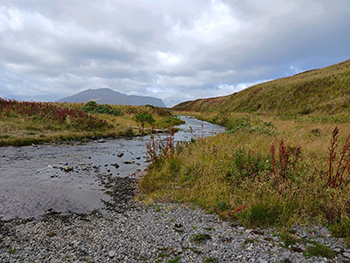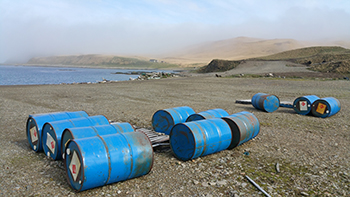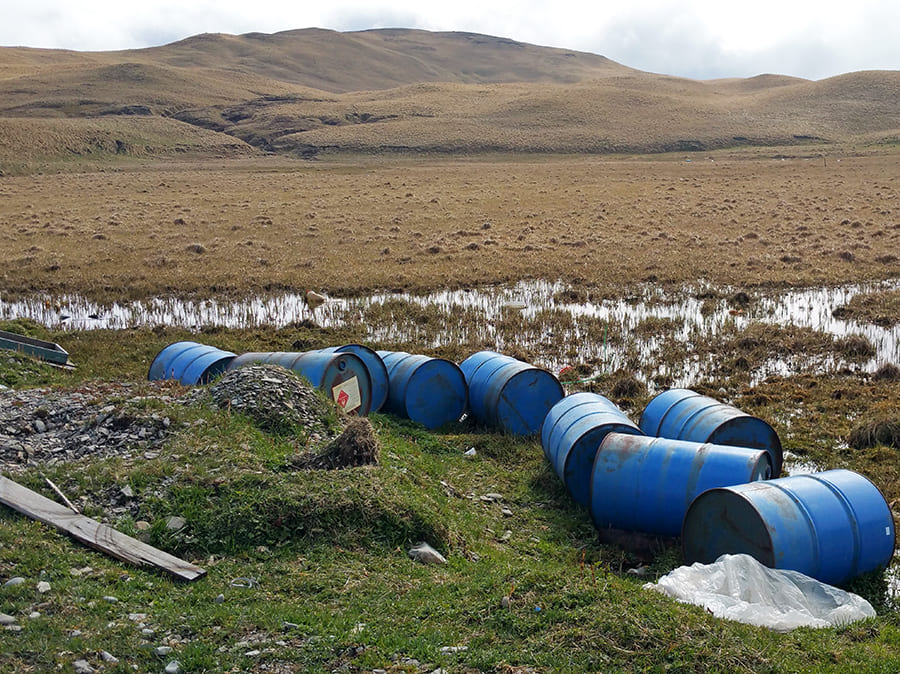Scientists in the College of Engineering are leading an effort to understand the potential for human exposure to toxic substances that may persist in the environment from hundreds of formerly used defense sites in Alaska.
“We are going to look for exactly what’s left over there and see how these chemicals are transported through the environment in response to climate change,” Frank Yang, project lead and environmental engineering professor in the Department of Civil and Environmental Engineering, said. “When the sites are warming up, more toxicants can be released into the environment. We will find and quantify impacts on the food web and outline possible steps for mitigation.”
The Arctic is contaminated by persistent organic pollutants from many sources, including the abandoned defense sites. As the climate warms, toxic substances that had been bound in arctic soils may become more mobile and enter the food web, potentially increasing human health risks from exposure to the chemicals.
“The big question is where to hunt and fish for best practice to protect their health,” Yang said. “There has been concern with the safety of subsistence foods collected near the military sites. It’s been an issue for a while.”

“One question of many arctic communities is if there are specific areas to avoid when harvesting food, and if people need to be concerned about toxicants when eating nutritious, traditional foods,” Chandra Poe, Environmental Program Director for Qawalangin Tribe, said.
The research team is collaborating closely with the Qawalangin Tribe of Unalaska and the City of Unalaska through a participatory research approach to understand the research questions of importance to the community, including potential risks of human exposure to these pollutants on Unalaska Island. The work is funded by a National Science Foundation grant of $1.6 million for four years.
The team will co-develop the project with the local community to promote the continuation of culturally important subsistence lifestyles, train residents in research and management techniques and foster proactive and sustainable public health risk management.
The community engaged research includes workshops, interviews and an environmental monitoring academy to collect the information and samples for priority community needs. Workshops and interviews will be conducted to identify research questions that are community-driven, grounded in tribal self-determination and at a system scale related to sustainable management of the persistent organic pollutants.
The environmental monitoring academy includes classroom sessions and field exercises on nutritional benefits of a subsistence diet, sources and health effects of contaminants, environmental mapping, sampling techniques, operation of analytical instruments and appropriate quality assurance/quality control procedures.
Students will collect and analyze environmental samples that are critical for comprehensive understanding of the former defense site pollution. To track broader impacts, the team will administer questionnaires at the end of workshops and academies to assess the extent to which the community is gaining tools and information to address issues surrounding the pollution.
“It might be low concentrations entering the environment, which can be accumulated and concentrated in animal tissues,” Yang said. “At some locations, toxicants are found in fish and shellfish, important food sources for coastal Alaskan communities. Ultimately, we want to determine which sites are polluted and how they can be mitigated.”

This project includes the disciplines of environmental chemistry, ecotoxicology and social-economic sciences to investigate pollution at this arctic site as it experiences rapid warming due to global climate change.
“Our team is excited to lead this project,” Yang, an associate professor in the College of Engineering, and an affiliated faculty member of the Nevada Water Innovation Institute and the Global Water Center at the University of Nevada, Reno, said. “We are co-developing the overall project with the Tribe and the Unalaska community, and we have a multi-disciplinary team including an environmental engineer/chemist, an ecotoxicologist and social scientists.”
The team includes, as co-principal investigators, Frank von Hippel from the University of Arizona, who is conducting an ecotoxicity study of the leftover pollutants; Jennifer Schmidt from the University of Alaska Anchorage, who is conducting workshops, interviews and mapping; Tobias Schwoerer of the University of Alaska Fairbanks, who is conducting an economic analysis for potential remediation or mitigation; and Chris Price, Chandra Poe and Elise Contreras from the Qawalangin Tribe of Unalaska, who are coordinating research with Tribe and local stakeholders and guiding the team on Tribal priorities.
Expected results will provide actionable science for arctic residents to manage human exposure to pollutants. The results will inform management and remediation efforts at the former defense sites and thereby provide knowledge to make informed decisions about local resources and minimize health hazards faced by the Unalaska community.















